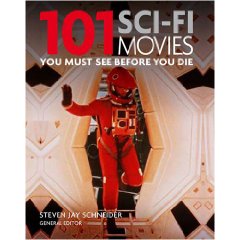 “Scientists in the nineteenth century could predict the automobile. Science fiction writers added the human element and envisioned traffic jams.†This anonymous statement probably describes the science fiction genre, literary or cinematic, as well as anyone has or ever will.
“Scientists in the nineteenth century could predict the automobile. Science fiction writers added the human element and envisioned traffic jams.†This anonymous statement probably describes the science fiction genre, literary or cinematic, as well as anyone has or ever will.
Any film buff will tell you, sci-fi fan or not, that compiling a list of just a hundred and one films to represent such a complex and at times contentious genre is a thankless job. The general editor of this delightful little gem is Steven Jay Schneider, a film critic, author and editor of several books on film and filmmaking while its publisher is Baron’s Educational Series Inc.
This pocket sized book more than punches above its weight as it takes the reader on a journey that lasts well over a hundred years. Schneider and his 33 contributors do an admirable job in not only including films of different eras and sub-genres of sci-fi but also a significant amount of non-English language cinema.
The 1902 French film “Voyage To The Moon†and the 2006 Anglo-American apocalyptic thriller “Children Of Men†are the two bookends that keeps the sci-fi genre from leaping out of its pages. In between, the reader has to deal with countless films about space travel, alien invasions, sci-fi adventures right here on Earth and of course, the classic sub-genre of the future dystopian society.
The older sci-fi fans will be delighted by the inclusion of classics like “Metropolisâ€(1927), “The Day The Earth Stood Stillâ€(1951), “2001: A Space Odysseyâ€(1968) and “Sleeper’(1973). While, “The Star Wars Trilogyâ€(1977-1983), “Alienâ€(1979), “E.T.: The Extra-Terrestrialâ€(1982) and yes, “Star Trek II: The Wrath Of Khanâ€(1982) will certainly satisfy the cravings of their children and grandchildren.
The obvious Hollywood blockbusters are not the book’s greatest strength but the inclusion of the likes of “Tronâ€(1982), “The Thingâ€(1982), “Akiraâ€(1988), “Alphavilleâ€(1965) and “Stalkerâ€(1979) which satisfy the cult, horror, anime and foreign language sub-genres of sci-fi respectively, certainly are.
The language of the various contributors keeps the reader relatively interested without making it too dull. Four pages is all that each film is given to make their case for inclusion in this elite list. These pages include the film poster, two informational pages (with great quotes from the film) and a still from the film.
However, there are a few missteps even by the competent writers of this fine book. The most glaring example is the labeling the George Lucas classic as “Star Wars: Episode VI –A New Hopeâ€(1977) instead of “Episode IV.” The inclusion and exclusion of a few sci-fi films will probably get more than a few fans up in arms. Surely, “Flash Gordonâ€(1980), “Starship Troopersâ€(1997) and maybe even “I Robotâ€(2004) can be sacrificed so that films like “Dark Cityâ€(1998), “A.I.â€(2001) and “Minority Reportâ€(2002) can thrive in the pages of this book.
Aside from these gripes, the hardcore and the casual fans of sci-fi have in front of them an encyclopedia that will give them joy and knowledge for years to come. Future updates of this compendium will almost certainly give recent films like “WALL-Eâ€(2008), “Star Trekâ€(2009) and “Moonâ€(2009) a chance to join this exclusive list and bump a few films off this one-stop guide to the best of science fiction.
Film fans of all genres should give this book a shot just for the fun facts like the strangulation of Jabba the Hutt in “Star Wars: Episode VI– Return Of The Jediâ€(1983) was inspired by “The Godfatherâ€(1972).
If that does not entice you, then maybe the fetching images of Raquel Welch, Carrie Fisher and Sigourney Weaver just might make you give it another look.
Sci-fi film fans can finally say with some considerable pride that when directors of the caliber of Fritz Lang, Jean-Luc Godard, Francois Truffaut, Stanley Kubrick, Andrei Tarkovsky, Woody Allen and Steven Spielberg have attempted to explore their genre, the results have usually been quite unique and spectacular and they now have a book to prove it.

Leave a Reply